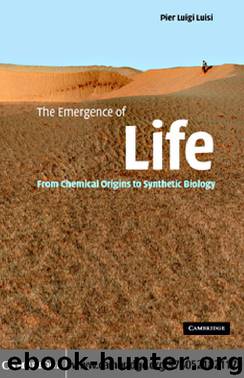The Emergence of Life by Pier Luigi Luisi

Author:Pier Luigi Luisi [LUISI, PIER LUIGI]
Language: eng
Format: epub
Published: 2011-02-16T05:00:00+00:00
What autopoiesis does not include
161
d[S]
vgen = d t
vdec = − d[S]
d t
if vgen = vdec
if vgen > vdec
if vgen < vdec
Figure 8.3 The minimal autopoietic system. This system is characterized by two competitive reactions, one that builds the components of the boundary, and another one that destroys them. According to the relative value of these two velocity constants, the system can be in homeostasis, or grow, or die.
one has to have a logical scheme describing how a car works and how motion is transmitted from the carburetor to the wheels. A classic citation by Maturana and Varela (1998) reads:
In order to reproduce something, the unit must first be constituted as a unit, with an organization that defines this unit itself. This is simple common sense logics.
Adding:
A living organism can also exist without being capable of self-reproduction.
Also, Varela asserts that to take reproduction into the definition of life would be ontologically wrong (Varela, 2000), as
reproduction is a . . .consequence of the existence of individuals. The difficult thing is to create an organism that is capable of self-reproducing with its own boundary. To divide it up in two is easy.
This notion, that reproduction is a consequence of the internal logic of life, can be visualized in Figure 8.3 (see also Luisi, 1996), which is an extension of the drawing of our Green Man (Figure 2.1) discussed in Chapter 2. It represents the various modes of existence of a minimal autopoietic system. This system is defined by a semi-permeable membrane formed by only one component S that allows the entrance of the nutrient A, which is transformed inside the system into S, the 162
Autopoiesis: the logic of cellular life
component that forms the system itself. There are two competitive reactions, one that forms S from A, with velocity vgen, and one that breaks down S into the by-product P, with velocity vdec. When the two velocities are numerically equal, the system is in homeostasis; when vgen is greater than vdec, the system can grow, and eventually give rise to a self-reproduction mode. Figure 8.3 clearly shows that self-reproduction can be seen as a particular kinetic pattern of homeostasis – a consequence of self-maintenance.
How does an autopoietic unit manage with evolution? Although evolution is not emphasized in the basic definitions, it is indeed an important part of autopoiesis.
However, it is expressed in quite different terms, and, almost paradoxically, is seen as a consequence of self-maintenance: the autopoietic unit tends to maintain its own identity and has no urge to change. When the necessity to change occurs, the cell adjusts with the minimal change, so as to disturb its own identity as little as possible; and it does this by facing the external stimuli with its own internal organization. This means that only changes that are in harmony with the internal organization are accepted. If this is possible, then changes are small; if it is not possible, the organism may die. By way of this mechanism, the autopoietic unit is in constant dialogue with the
Download
This site does not store any files on its server. We only index and link to content provided by other sites. Please contact the content providers to delete copyright contents if any and email us, we'll remove relevant links or contents immediately.
Sapiens: A Brief History of Humankind by Yuval Noah Harari(14312)
Sapiens by Yuval Noah Harari(5321)
Pale Blue Dot by Carl Sagan(4949)
Homo Deus: A Brief History of Tomorrow by Yuval Noah Harari(4870)
Livewired by David Eagleman(3728)
Origin Story: A Big History of Everything by David Christian(3665)
Brief Answers to the Big Questions by Stephen Hawking(3392)
Inferior by Angela Saini(3293)
Origin Story by David Christian(3169)
Signature in the Cell: DNA and the Evidence for Intelligent Design by Stephen C. Meyer(3097)
The Gene: An Intimate History by Siddhartha Mukherjee(3074)
The Evolution of Beauty by Richard O. Prum(2962)
Aliens by Jim Al-Khalili(2802)
How The Mind Works by Steven Pinker(2769)
A Short History of Nearly Everything by Bryson Bill(2659)
Sex at Dawn: The Prehistoric Origins of Modern Sexuality by Ryan Christopher(2500)
From Bacteria to Bach and Back by Daniel C. Dennett(2462)
Endless Forms Most Beautiful by Sean B. Carroll(2442)
Who We Are and How We Got Here by David Reich(2416)
